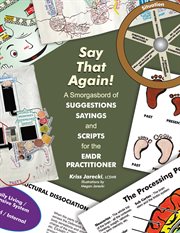Details
PUBLISHED
Made available through hoopla
DESCRIPTION
1 online resource
ISBN/ISSN
LANGUAGE
NOTES
Though this book is written with the EMDR practitioner in mind, it has several chapters of suggestions, scripts and ways to word discussions that can assist any practitioner. The book takes the therapist on a journey from "hello" to "congratulations, you completed treatment!" The journey starts with suggestions for creating a trauma-informed and trauma-sensitive office. This includes how to decorate and arrange a waiting room, training staff that also interact with clients and how to organize a a therapy session. Then, you'll be introduced to four different ways to explain and illustrate the Adaptive Information Processing Modal (AIP). Via metaphors such as the "sandwich" analogy, you'll learn how our brain and body digest experiences, what can cause brain "indigestion" and ways to suggest therapies such as EMDR as a solution. This leads us into a hearty exploration of the brain on trauma. Follow the clearly written and illustrated map of how the brain (limbic and Cortexes), chemistry (Serotonin, Cortisol, etc.) and the nervous system (brain stem and Polyvagal nervous systems) work together to help our body and brain know how to react or not react in different situations (Adaptive Information Processing or AIP). Then, on to history taking. We need to gather information in order to provide an informed case formulation and treatment recommendations. However, sharing history can be upsetting for clients. In this section you'll find scripts for gathering an adult's history using the "Journey of Not-So-Good Experiences" and the "Journey of Good Times and Great Oldies Positive Experiences" that's written in a trauma sensitives way. You'll also find directions and a script for the "Tree of Me" to gather good and not-so-good things with kids! Then, explore presenting a case formulation using "As the Wheel Turns." When recommending therapies such as EMDR to clients, it's important to have an understanding of how it works. Using words and illustrations, we will take a look at the various hypothesis for how therapies like EMDR work such as mimicking what happens during REM sleep or how it utilizes working memory and facilitates mindfulness. Then, we move on to scripted protocols for teaching clients resource tools such as the "TV/Computer Tool" and "Positive Parts on the Team" that assist clients in managing feelings and situations. We will also take a look at other preparations such as understanding the spectrum of dissociation and some ideas for determining how much a client feels "in the room" along with tools to facilitate a grounded presence for the client. The journey continues with more scripts and ways to discuss the standard EMDR protocol along with protocol variations such as working with clusters (things that happen over and over again), utilizing floatback (a way to help connect past events to how current situations are experienced) when to use cognitive interweaves (assisting clients who get "stuck") and implementing future work (preparing for anticipated events). We will end our journey with a look at EMDR and telehealth, the "Seed to Weed Technique" as an over-all treatment approach and suggestions for mapping the road a client will follow after completing therapy. Look inside for much more!
Mode of access: World Wide Web







